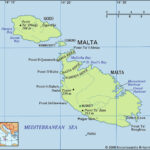Borneo, a name that conjures images of lush rainforests, exotic wildlife, and vibrant cultures, is a captivating island that beckons to be explored. But Where Is Borneo exactly? Nestled in the heart of Southeast Asia, Borneo is the third-largest island in the world, surpassed only by Greenland and New Guinea. This sprawling landmass sits in the southwestern reaches of the Pacific Ocean, offering a unique geographical and cultural tapestry that sets it apart.
Geographically, Borneo is positioned southeast of the Malay Peninsula and forms part of the Greater Sunda Islands group within the Malay Archipelago. It’s bordered by several significant bodies of water: the South China Sea to the northwest, the Sulu Sea to the northeast, the Celebes Sea to the east, and the Java Sea to the south, which separates it from the island of Java. The Makassar Strait marks its eastern divide from the island of Celebes (Sulawesi), while a series of shallower seas and straits lie to the west, separating Borneo from Sumatra.
Borneo’s Diverse Landscape and Geography
Straddling the Equator, Borneo boasts a tropical climate and a diverse topography. The island stretches approximately 830 miles (1,336 km) from northeast to southwest and reaches a maximum breadth of 600 miles (960 km). While largely mountainous, Borneo also features extensive lowlands, particularly in Central Kalimantan and Sarawak, often characterized by swampy coastal regions.
Sultan Omar Ali Saifuddien Mosque
A prominent feature of Borneo’s landscape is its mountain ranges, which extend southwestward from Mount Kinabalu in the northeast. Mount Kinabalu, soaring to 13,455 feet (4,101 meters), is not only Borneo’s highest point but also the tallest peak in Malaysia, showcasing the island’s dramatic elevations. The central spine of mountains includes the Crocker, Nieuwenhuis, and Muller ranges. Further adding to the complexity of Borneo’s terrain, the Kapuas Hulu Mountains branch westward, and discontinuous ranges run parallel to the east and southeast coasts.
Navigable rivers are crucial to Borneo’s geography, serving as vital arteries for trade and transportation. These rivers, particularly the Kapuas in the west and the Mahakam in the east of Kalimantan, are the lifelines of commerce. However, in the narrower northern parts of the island, rivers are less navigable, contributing to the historical isolation of Borneo’s interior. The Rajang River in East Malaysia (Sarawak) is another significant waterway.
Climate, Flora, and Fauna: Borneo’s Natural Splendor
Borneo’s equatorial climate is characterized by hot and humid conditions throughout the year. The island experiences two main seasons: a wet monsoonal period, locally known as landas, from October to March, and a relatively drier summer period, tedoh, for the remainder of the year. Rainfall is abundant, averaging around 150 inches (3,800 mm) annually, nurturing the island’s rich ecosystems.
Dense rainforests dominate Borneo’s landscape, fostering incredible biodiversity in both flora and fauna. The island is home to valuable timber trees like teak, oak, conifers, and hardwoods of the Dipterocarpaceae family. Borneo’s forests are also famed for epiphytes and the Rafflesia arnoldii, the extraordinary “monster flower,” which is the largest single flower on Earth.
orangutan in a tropical forest in Borneo
Borneo’s fauna is equally remarkable, with endemic species like the Bornean clouded leopard and the proboscis monkey. Orangutans, gibbons, and elephants also inhabit the island, contributing to its rich wildlife. While the Sumatran rhinoceros is now unfortunately extinct in Borneo, the island still teems with a vast array of birds, insects, and fish.
People and Economy of Borneo
Despite its size, Borneo is sparsely populated compared to other parts of Asia. The island’s population is diverse, including non-Muslim Dayaks, Islamic Malays, Chinese, and smaller European minorities. The highest population densities are found in South Kalimantan and along the eastern, western, and northern coasts.
Economically, Borneo has limited commercial mineral resources. Historically, gold, diamonds, antimony, mercury, gypsum, and iron have been mined on a small scale. However, oil fields at Tanjung Balikpapan, Brunei, and offshore areas have become significant. Bauxite and coal are also resources that have been developed.
Agriculture plays a crucial role in Borneo’s economy. Rice is the staple crop, supplemented by corn, cassava, cucumber, and pumpkin. Rubber and pepper are also cultivated. Coastal exports include sago, copra, cutch, and marine products. Emerging markets include shorea seeds and chicle, with experimental plantings of coffee, cocoa, and hemp diversifying the agricultural landscape.
In conclusion, Borneo is located in Southeast Asia, a vast and biodiverse island shared by Indonesia, Malaysia, and Brunei. Its strategic location, diverse geography, rich ecosystems, and vibrant cultures make it a fascinating and important part of the world. From its towering mountains to its intricate river systems and lush rainforests teeming with life, Borneo offers a captivating blend of natural beauty and cultural richness, making it a compelling destination for exploration and discovery.

